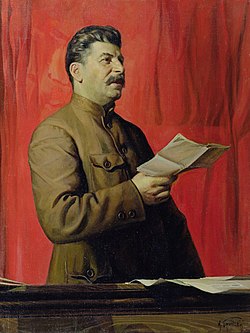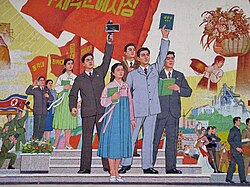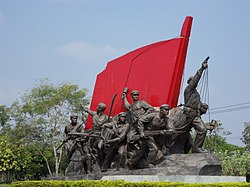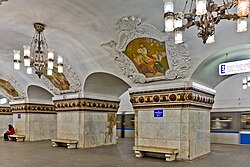
Back Sosialistiese realisme Afrikaans واقعية اشتراكية Arabic Realismu socialista AST Sosialist realizmi Azerbaijani Сацыялістычны рэалізм Byelorussian Сацыялістычны рэалізм BE-X-OLD Социалистически реализъм Bulgarian Realisme socialista Catalan Socialistický realismus Czech Socialistisk realisme Danish
This article needs additional citations for verification. (April 2021) |
Top to bottom: Portrait of J.V. Stalin by Isaak Brodsky (1933); Mural in North Korea; Statue in Vientiane, Laos; Kiyevskaya station in the Moscow Metro | |
| Years active | 1932 - present |
|---|---|
| Location | Socialist countries |
| Influences | Marxism, Realism |
Socialist realism was the official cultural doctrine of the Soviet Union that mandated an idealized representation of life under socialism in literature and the visual arts. The doctrine was first proclaimed by the First Congress of Soviet Writers in 1934 as approved method for Soviet cultural production in all media.[1] Following World War II, socialist realism was adopted by countries politically aligned with the Soviet Union.[2] The primary official objective of socialist realism was "to depict reality in its revolutionary development" although no formal guidelines concerning style or subject matter were provided.[1]
It was usually characterized by unambiguous narratives or iconography relating to the Marxist–Leninist ideology, such as the emancipation of the proletariat.[3] Despite its name, the figures in the style are very often highly idealized, especially in sculpture, where it often leans heavily on the conventions of classical sculpture. Although related, it should not be confused with social realism, a type of art that realistically depicts subjects of social concern and was popularized in the United States during the 1930s,[4] or other forms of "realism" in the visual arts. Socialist realism was made with an extremely literal and obvious meaning, usually showing an idealized USSR. Socialist realism was usually devoid of complex artistic meaning or interpretation.[5][6]
Socialist realism was the predominant form of approved art in the Soviet Union from its development in the early 1920s to its eventual fall from official status beginning in the late 1960s until the breakup of the Soviet Union in 1991.[7][8] While other countries have employed a prescribed canon of art, socialist realism in the Soviet Union persisted longer and was more restrictive than elsewhere in Europe.[9]
- ^ a b Elliott, David; Juszkiewicz, Piotr (2003), "Socialist Realism", Oxford Art Online, Oxford University Press, doi:10.1093/gao/9781884446054.article.t079464, ISBN 978-1-884446-05-4, retrieved 2023-11-26
- ^ "Socialist Realism | art". Encyclopedia Britannica.
- ^ Korin, Pavel, "Thoughts on Art", Socialist Realism in Literature and Art. Progress Publishers, Moscow, 1971, p. 95.
- ^ Todd, James G. "Social Realism". Art Terms. Museum of Modern Art, 2009.
- ^ Morson, Gary Saul (1979). "Socialist Realism and Literary Theory" (PDF). The Journal of Aesthetics and Art Criticism. 38 (2): 121–133. doi:10.1111/1540_6245.jaac38.2.0121. JSTOR 430715.
- ^ Stefan Baghiu (January 2016). "TRANSLATING NOVELS IN ROMANIA: THE AGE OF SOCIALIST REALISM. FROM AN IDEOLOGICAL CENTER TO GEOGRAPHICAL MARGINS".
{{cite journal}}: Cite journal requires|journal=(help) - ^ Encyclopedia Britannica on-line definition of Socialist Realism
- ^ Ellis, Andrew. Socialist Realisms: Soviet Painting 1920–1970. Skira Editore S.p.A., 2012, p. 20
- ^ Valkenier, Elizabeth. Russian Realist Art. Ardis, 1977, p. 3.
© MMXXIII Rich X Search. We shall prevail. All rights reserved. Rich X Search



